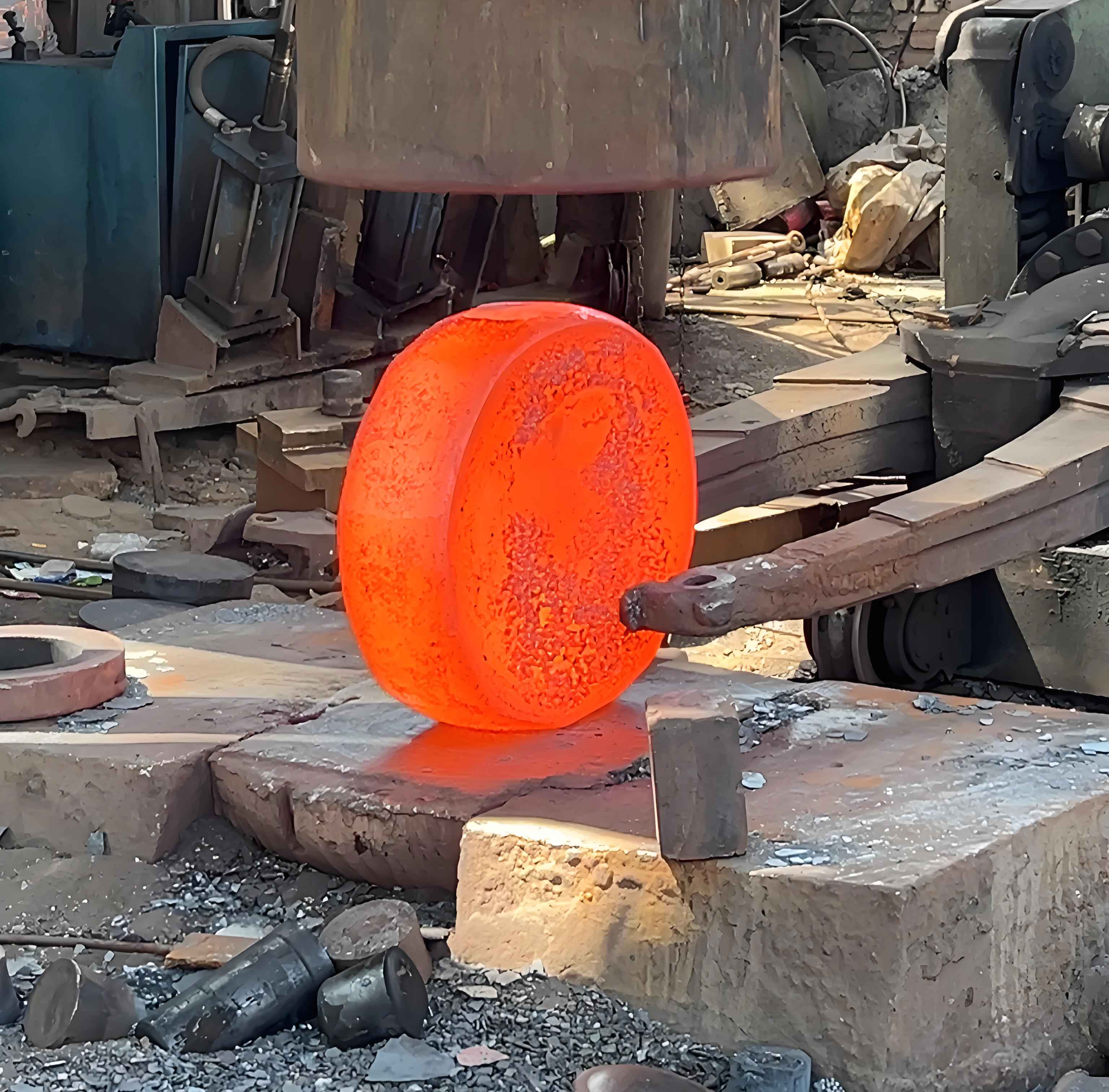Manufacturing large forged gear blanks for mining machinery, turbines, and generators demands advanced techniques to overcome excessive deformation forces, incomplete die filling, and heat treatment challenges. Conventional methods often result in shallow hardening depths and stress cracking at transitional sections. This article details comprehensive process innovations validated through thermomechanical simulation and metallurgical analysis.
Metal Flow Dynamics in Gear Blank Forging
Forging involves three distinct phases: upsetting, transitional filling, and flash formation. During upsetting, billet-die contact generates non-uniform axial flow governed by:
$$ \frac{\partial v_z}{\partial t} = -\frac{1}{\rho}\nabla p + \nu\nabla^2 v_z + g_z $$
where $v_z$ = axial velocity, $p$ = pressure, $\rho$ = density, $\nu$ = kinematic viscosity, and $g_z$ = gravitational acceleration. Radial flow velocity differentials emerge as:
$$ \Delta v_r = k(T)\cdot\mu\cdot\frac{\delta\sigma}{\delta r} $$
with $k(T)$ = temperature-dependent flow stress coefficient, $\mu$ = friction coefficient. Finite element analysis (Figure 1) confirms accelerated centerline flow and peripheral stagnation:

| Forging Stage | Peripheral Temp (°C) | Core Temp (°C) | Flow Differential (%) |
|---|---|---|---|
| Upsetting | 820 | 950 | 12-18 |
| Transition Filling | 650 | 910 | 22-32 |
| Flash Formation | 480 | 880 | 38-45 |
Distributary Decompression Forging
Conventional methods required 4,200-ton force exceeding press capacity. The innovative solution incorporates pre-forged decompression grooves and oversized central bore (Figure 2) to redirect metal flow. Stress reduction follows:
$$ \sigma_{eff} = \sigma_0 \left[1 – e^{-\beta\left(\frac{A_d}{A_c}\right)}\right] $$
where $\sigma_0$ = baseline stress, $\beta$ = material constant, $A_d$ = groove area, $A_c$ = contact area. Process parameters for Φ1000mm gear blanks:
| Parameter | Conventional | Improved |
|---|---|---|
| Preform Design | Flat billet | Grooved billet |
| Central Bore (mm) | 0 | Φ220 |
| Deformation Force (tons) | 4200 | 2900 |
| Filling Efficiency | 72% | 98% |
Asymmetric Die Optimization
Counteracting axial flow imbalance required differential cavity depths. Velocity gradients were minimized through depth ratio optimization:
$$ R_d = \frac{H_u}{H_l} = 1.25 \ln\left(\frac{D}{t}\right) – 0.18 $$
where $H_u$ = upper die depth, $H_l$ = lower die depth, $D$ = blank diameter, $t$ = rib thickness. For Φ1000mm blanks with 195mm ribs:
$$ R_d = 1.25 \ln\left(\frac{1000}{195}\right) – 0.18 = 1.86 $$
Asymmetric designs reduced stress concentration by 40% and eliminated underfill defects in transitional zones.
Enhanced Heat Treatment Protocol
Modified 42CrMo4V alloy (Table 1) enables deeper hardening while stepped quenching prevents cracking. Composition modifications enhance hardenability:
| Element | Conventional | Improved | Effect |
|---|---|---|---|
| C | 0.41-0.45 | 0.41-0.45 | – |
| Mn | 0.60-0.80 | 0.80-1.00 | ↑ Hardenability |
| Cr | 0.90-1.20 | 1.05-1.20 | ↑ Carbide formation |
| Mo | 0.15-0.30 | 0.20-0.25 | ↑ Temper resistance |
| P/S | ≤0.025 | ≤0.020 | ↓ Segregation |
The thermal sequence combines normalizing and stepped quenching:
$$ T_{norm} = A_{c3} + 40^\circ C \rightarrow \frac{dT}{dt} = 1.2^\circ C/min \times t_{sec} $$
$$ T_{quench} = 850^\circ C \xrightarrow{\text{AQ251}} 280^\circ C \xrightarrow{\text{hold}} \text{air cool} $$
Critical transformation kinetics:
$$ t_{0.9} = 0.8 \exp\left(\frac{Q}{RT}\right) C^{0.13}\text{Mn}^{0.32}\text{Cr}^{0.27} $$
where $Q$ = activation energy (280 kJ/mol), $R$ = gas constant, $T$ = absolute temperature.
Metallurgical and Mechanical Validation
Processed gear blanks exhibit superior properties:
| Property | Requirement | Result |
|---|---|---|
| Tensile Strength | 900-1050 MPa | 980±25 MPa |
| Yield Strength | >750 MPa | 820±18 MPa |
| Impact Energy (-40°C) | >42J | 58±6J |
| Hardness Gradient | <25 HB | 12-18 HB |
| Grain Size (ASTM) | 6-7 | 6.5-7 |
Microstructure analysis confirms tempered sorbite with grain boundary ferrite <5%. Non-metallic inclusions remain below 0.5 (ASTM scale) with oxide content ≤20ppm. The combined approach enables production of premium forged gear blanks with 30% lower press requirements and guaranteed hardening depth >15mm.
